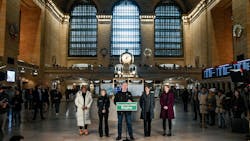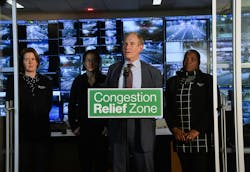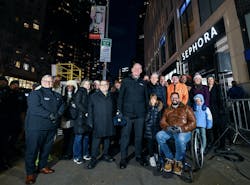The Metropolitan Transportation Authority (MTA) activated Central Business District (CBD) Tolling, the country’s first congestion pricing program.
Congestion pricing features a 40 percent reduction in all tolls for vehicles entering the city’s CBD, saving commuters up to $1,500 per year. The plan also includes new tools to reduce congestion and air pollution in communities citywide to ensure the plan achieves the goals of congestion pricing, including $15 billion in mass transit funding to support the MTA’s current capital program.
MTA notes the Congestion Relief Zone is the most transit-rich area in the U.S., with 94 subway stations, 99 MTA bus routes and 2,500 regional/commuter trains per day on the Long Island Rail Road (LIRR), Metro-North Railroad, New Jersey Transit and PATH, allowing more than 85 percent of commuters into the zone to rely on transit. The agency says the toll is projected to lead to 80,000 fewer vehicles entering the Congestion Relief Zone daily.
"The Congestion Relief Zone has been in operation since midnight – 1,400 cameras, over 110 detection points, over 800 signs and 400 lanes of traffic and it’s all gone smoothly,” said MTA Chair and CEO Janno Lieber. “We want to encourage trucks to do more deliveries at night, we want improvements to vehicle speeds especially for buses, we want to make sure that emergency response vehicles can get where they are going faster and I hope drivers will take another look at the speed and convenience of mass transit.”
"Thanks to congestion pricing, MTA Construction & Development will undertake a generational investment to transform public transit in New York," said MTA Construction & Development President Jamie Torres-Springer. "We're ready to get these projects started and we're ready to deliver them better, faster and cheaper than ever before."
Congestion pricing was supposed to launch in New York City (NYC) on June 30. In early June, during a pre-recorded announcement, New York Gov. Kathy Hochul directed the MTA to “indefinitely delay” the start of congestion pricing because the program “risked too many unintended consequences for New Yorkers at this time.”
Six days after the program was paused, the MTA Board revealed it would not salvage the plan due to the state of New York’s pull of support. On Nov. 14, Hochul revealed plans to launch the program by January 2025.
On Nov. 18, the MTA Board approved a plan to phase in new tolls as a part of congestion pricing during the next six years. With the new feature, all initial toll rates will be 60 percent of the initially approved rates in 2025, 2026, and 2027. Automobiles will be charged $9 during peak periods and $2.25 overnight. All other toll rates, including those for trucks, buses and motorcycles, as well as all crossing credits, will be 60 percent of the initially approved rates. From 2028 to 2030, the rates will stand at 80 percent of the initially approved rates – $12 for automobiles during peak times and $3 overnight. The full undiscounted rates will begin in 2031.
MTA notes that during the years-long environmental review and toll-setting processes, hundreds of public meetings and 19 public webinars were held across the 28-county region, including meetings with different stakeholder groups, with a special focus on environmental justice communities. The agency says 10 public hearings totaling 56 hours were held and more than 102,000 comments were received from the program’s outreach periods.
According to MTA, as part of the multifaceted public education campaign, 11 public webinars with more than 1,100 attendees were held in December, including webinars with a focus on the low-income discount plan and individual disability exemption plan, going over eligibility and how to apply. The agency says 20 outreach events were held in the transit system, 200 informational messages were posted to official MTA social media channels and 10 informational updates in the form of a newsletter were sent to 6,000 recipients. Ads appeared in 46 newspapers, covering nine languages, and aired on multiple radio stations in 10 languages.
“The start of congestion pricing is a historic moment for the New York region, the nation and MTA Bridges and Tunnels, who has shepherded the program since the beginning and will oversee its tolling operations,” said MTA Bridges and Tunnels President Cathy Sheridan. “Congestion pricing will not only benefit mass transit users, but less congestion means safer streets for both pedestrians and motorists – aligning with our own efforts of moving traffic safely and efficiently on our nine iconic crossings.”
Better transit
MTA notes 80 percent of the revenue generated will go to capital improvements on NYC subways and buses while 10 percent of the revenue will go to Metro-North Railroad and the final 10 percent will go to the LIRR.
After the pause on congestion pricing was lifted, the MTA exercised the option to purchase 265 zero-emission buses on Nov. 27. With congestion pricing having begun, the MTA has already started to advance additional capital projects, with these five the first to move:
- Second Avenue Subway Phase 2: The MTA issued a request for proposals to the contracting community for Phase 2’s major tunneling contract on Dec. 24.
- Modernization of signals A, C line in Brooklyn: The MTA issued a request for qualifications to the contracting community on Dec. 30. The modernization will allow the MTA to operate trains more frequently and more reliably on the line that serves 640,000 people per day.
- Subway station accessibility upgrades: The MTA issued a request for qualifications to the contracting community on Dec. 30 to upgrade three subway stations, Gates Avenue J, Z, Briarwood E, F and Parsons F, to make them accessible to all in accordance with the Americans with Disabilities Act.
- Reconstruction of the Verrazzano-Narrows Bridge’s ramps in Brooklyn: The MTA issued a request for proposals to the contracting community on Dec. 16.
- Dehumidification of the Verrazzano-Narrows Bridge’s main cables to extend their life: The MTA issued a request for proposals to the contracting community on Dec. 20.
MTA says congestion pricing moving forward also unlocks critical investments in MTA Bridges & Tunnels that were had been put on hold pending the start of the program. The MTA is already moving forward on the first two.
Train and bus service enhancements
- Subway: MTA notes subway service continues to deliver the best on-time performance in the past 10 years and between July 2023 and July 2024, New York City (NYC) Transit increased off-peak service across 12 subway lines:
- On July 2, 2023, weekend service frequency was increased on the G, J and M lines. The service increase would have trains arriving every eight to nine minutes instead of every 10 to 11 minutes.
- On Aug. 7, 2023, C trains began running every eight minutes instead of 10 minutes on weekdays.
- On Aug. 12, 2023, weekend service was enhanced on the 1 and 6 lines, with trains coming approximately six minutes instead of every eight minutes.
- On Aug. 28, 2023, weekday service was enhanced on the N and R lines, with trains arriving every eight minutes instead of every 10 minutes between 10:00 a.m. and 4:00 p.m. on the N and between 11:30 a.m. and 4:00 p.m. on the R on weekdays.
- On Dec. 17, 2023, evening service was increased on the C, N and R lines, and midday service was increased on the G line.
- On July 1, 2024, NYC Transit brought service frequencies to every eight minutes on the weekday midday and evening service on the B, D, J and M lines and added weekend service on the 3 and 5 lines to bring trains to operate every 10 minutes.
- Buses: Starting in the spring, the MTA will enhance service across 24 routes in all five boroughs, eight express bus routes and 16 local bus routes. Additionally, the MTA is redesigning all the boroughs’ bus networks to develop a better bus network that improves reliability, speeds up commutes and better meets the travel patterns of today and future riders. Most recently, the agency announced the latest milestone for the Queens Bus Network Redesign with release of the proposed final plan addendum, and the MTA Board is expected to vote on the plan this winter. MTA notes the Staten Island Express Bus Network Redesign and the Bronx Local Bus Network Redesign have been successfully implemented, with notable service increases during off-peak periods and other service improvements, resulting in an increase of six percent ridership since launch. In coordination with the New York City Department of Transportation, implementation of busways has led to 27 percent increases in bus speed and up to 60 percent increases when combined with other select bus service treatments.
- LIRR: With the opening of Grand Central Madison, MTA says systemwide service increased an overall 41 percent, more than 77,000 more trains a year, about a 35 percent increase at eastern Queens stations, 30 percent increase in Brooklyn trains (55 percent increase in weekend service) and 50 percent increase in reverse peak service. A $7 peak City Ticket was introduced for travel on the LIRR and Metro-North Railroad between commuter railroad stations within city limits, and an LIRR Far Rockaway ticket, offering more cost-conscious fare options.
- Metro-North Railroad: To increase transit options and encourage ridership, Metro-North Railroad has increased service in the Bronx, which is complemented by discounts offered by the $7 peak CityTicket and continues to deliver on-time performance levels of 98 percent. Metro-North Railroad increased monthly discounts by 78 percent to 90 percent on UniTickets covering travel on the ferries and buses that cross the Hudson River to connect riders with Metro-North’s Hudson Line and slashed parking rates by 25 percent for Orange and Rockland residents using Metro-North Railroad’s garage in North White Plains.
MTA notes that as of Jan. 4, both railroads launched their “Winter Weekend” discount program, which enables monthly ticketholders to travel anywhere the railroads go and bring friends of family for just $1 each.
Millions dedicated to environmental justice communities
According to MTA, the program provides $335 million in mitigation programs, including $148 in regional mitigation measures and monitoring of traffic, air quality and transit station elements and $82 million for the low-income discount plan. In addition, the program also committed $100 million in funding for place-based mitigation to 13 environmental justice communities in the Bronx, Brooklyn, Upper Manhattan and New Jersey.
About the Author
Brandon Lewis
Associate Editor
Brandon Lewis is a recent graduate of Kent State University with a bachelor’s degree in journalism. Lewis is a former freelance editorial assistant at Vehicle Service Pros in Endeavor Business Media’s Vehicle Repair Group. Lewis brings his knowledge of web managing, copyediting and SEO practices to Mass Transit magazine as an associate editor. He is also a co-host of the Infrastructure Technology Podcast.



